| Article ID | Journal | Published Year | Pages | File Type |
|---|---|---|---|---|
| 305628 | Soil and Tillage Research | 2015 | 11 Pages |
•Tillage and cover crop (CC) affect the weed density and weed biomass in DSR.•Lower herbicide efficacy in ZT and CC plots led to higher weed pressure.•CONT recorded higher grain yield than ZT in dry-seeded rice system.•Pendimethalin fb bispyribac-sodium recorded higher grain yield over weedy check.•Results will help in formulating integrated weed management in DSR.
The adoption of dry direct seeding of rice in many Asian countries has resulted in increased interest among weed scientists to improve weed management strategies, because of the large and complex weed flora associated with dry-seeded rice (DSR). Tillage and cover cropping practices can be integrated into weed management strategies as these have been known to affect weed emergence for several ecological reasons. A study was conducted in the summer seasons of 2012 and 2013 at the Punjab Agricultural University, Ludhiana, India, to evaluate the effects of tillage, cover cropping, and herbicides on weed growth and grain yield of DSR. Most of the weed species (Echinochloa crus-galli, Echinochloa colona, Eleusine indica, and Euphorbia hirta) under study tended to populate the cover crop (CC) treatment more than the no-cover crop (no-CC) treatment. Zero tillage (ZT) resulted in higher weed densities of most of the weed species studied. The interaction effects of these treatments suggest that lesser herbicide efficacy in ZT and CC plots led to higher weed pressure and weed biomass. Grain yield was significantly higher in the conventional tillage system (2.40–3.32 t ha−1), because of lesser weed pressure, than in ZT (2.08–2.73 t ha−1). Almost all weed species increased in number and biomass production in the second year (2013) compared with the preceding year. Herbicide application (pendimethalin followed by bispyribac-sodium) alone, though significantly increased DSR grain yield over that of the unsprayed check, resulted in lesser grain yield compared with the weed-free check (5.07–5.12 t ha−1) by 14% and 27% in 2012 and 2013, respectively. This was mainly due to the buildup of biomass by weeds that escaped from herbicide application. The study reveals that conservation practices such as ZT can form an important component of integrated weed management in DSR, provided that herbicide efficacy be improved by adjusting rate and time of herbicide application in such systems.
